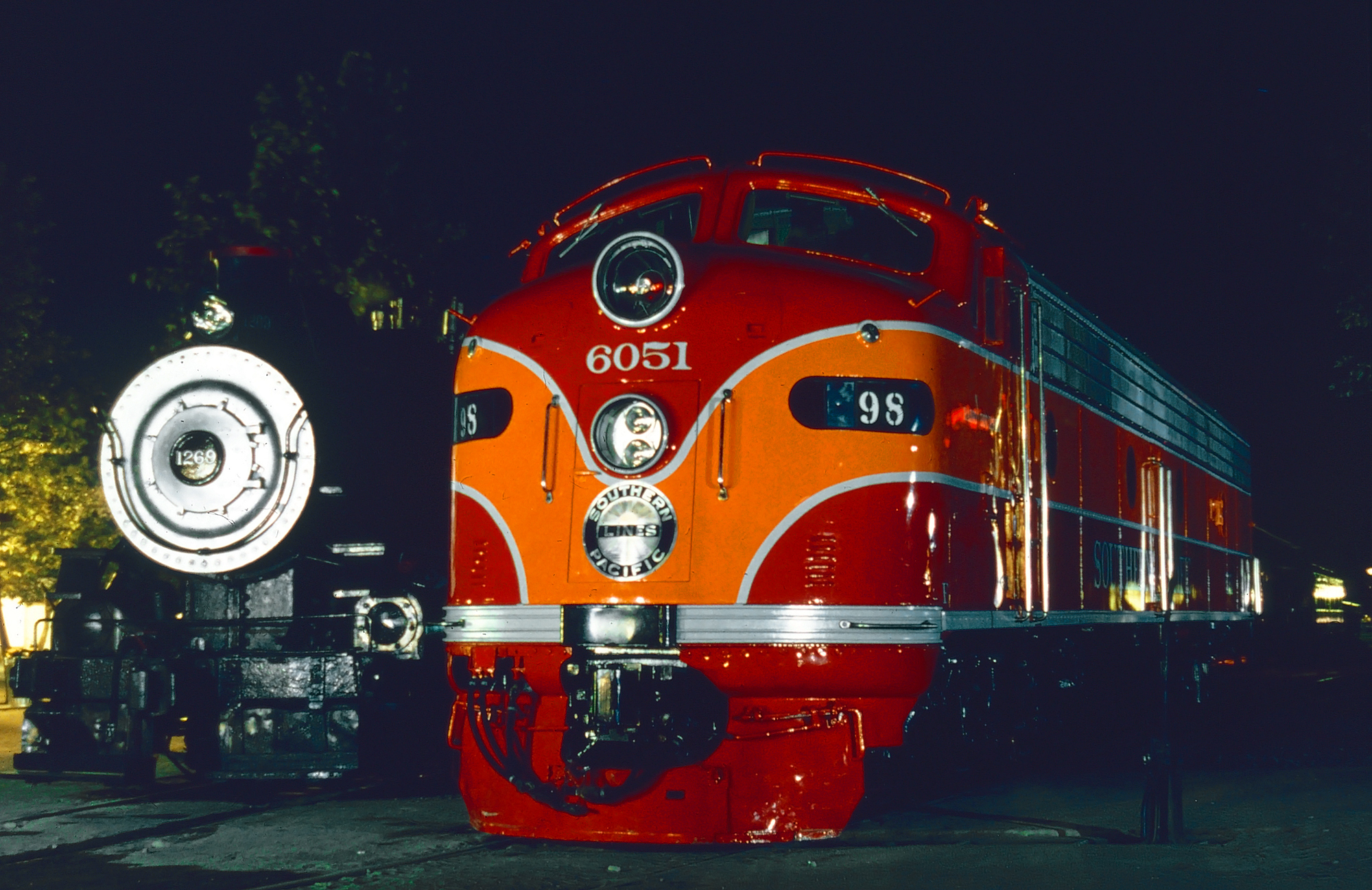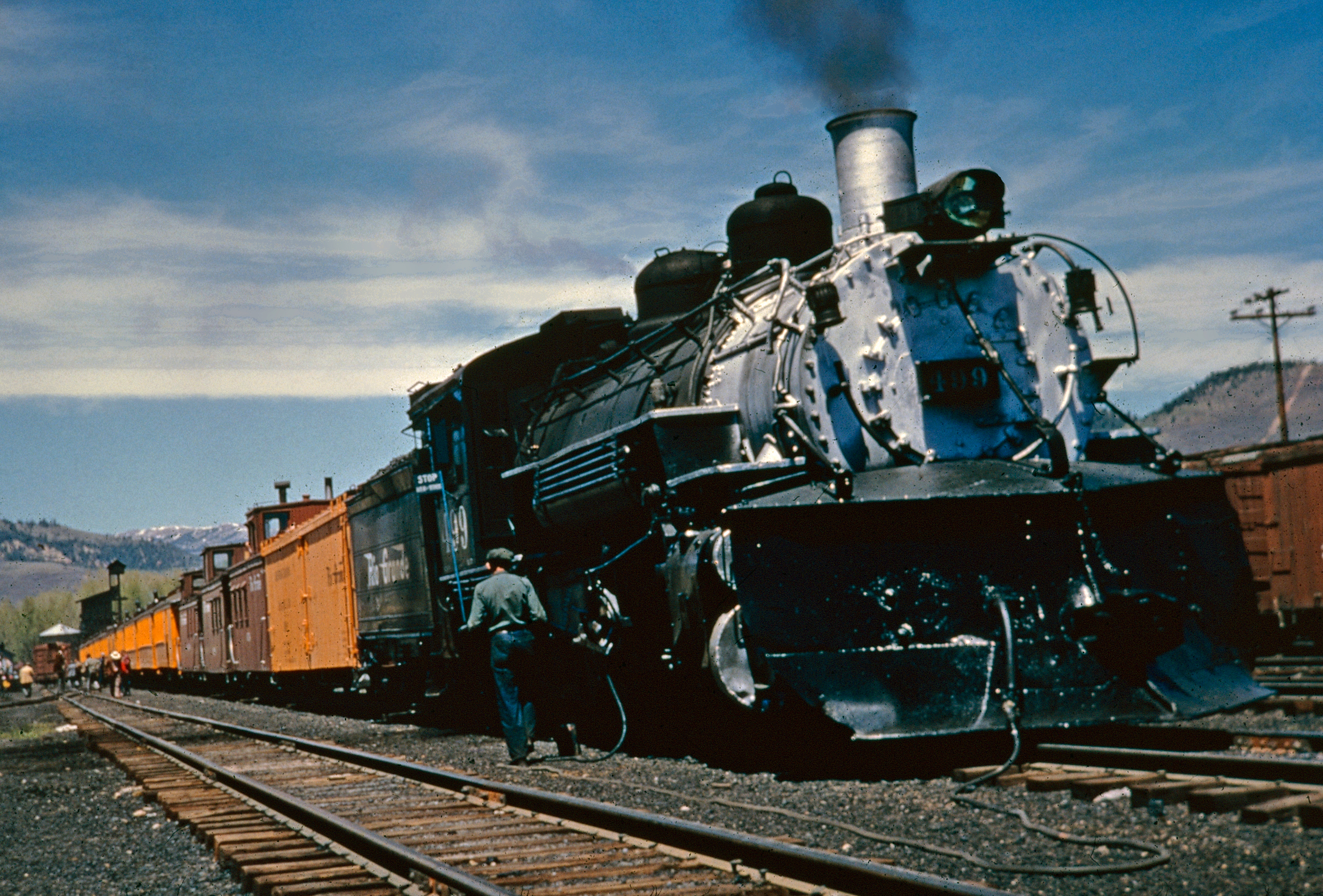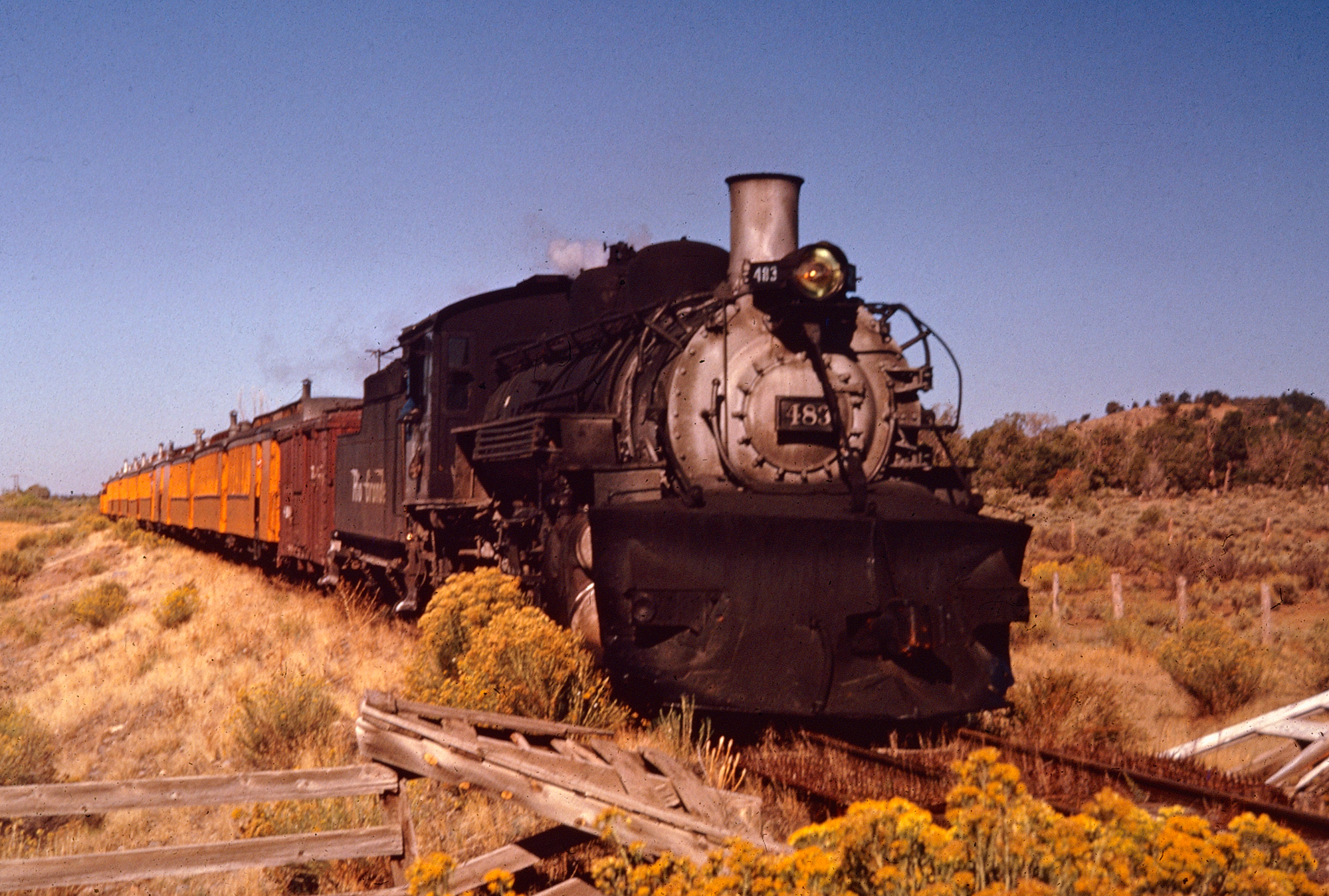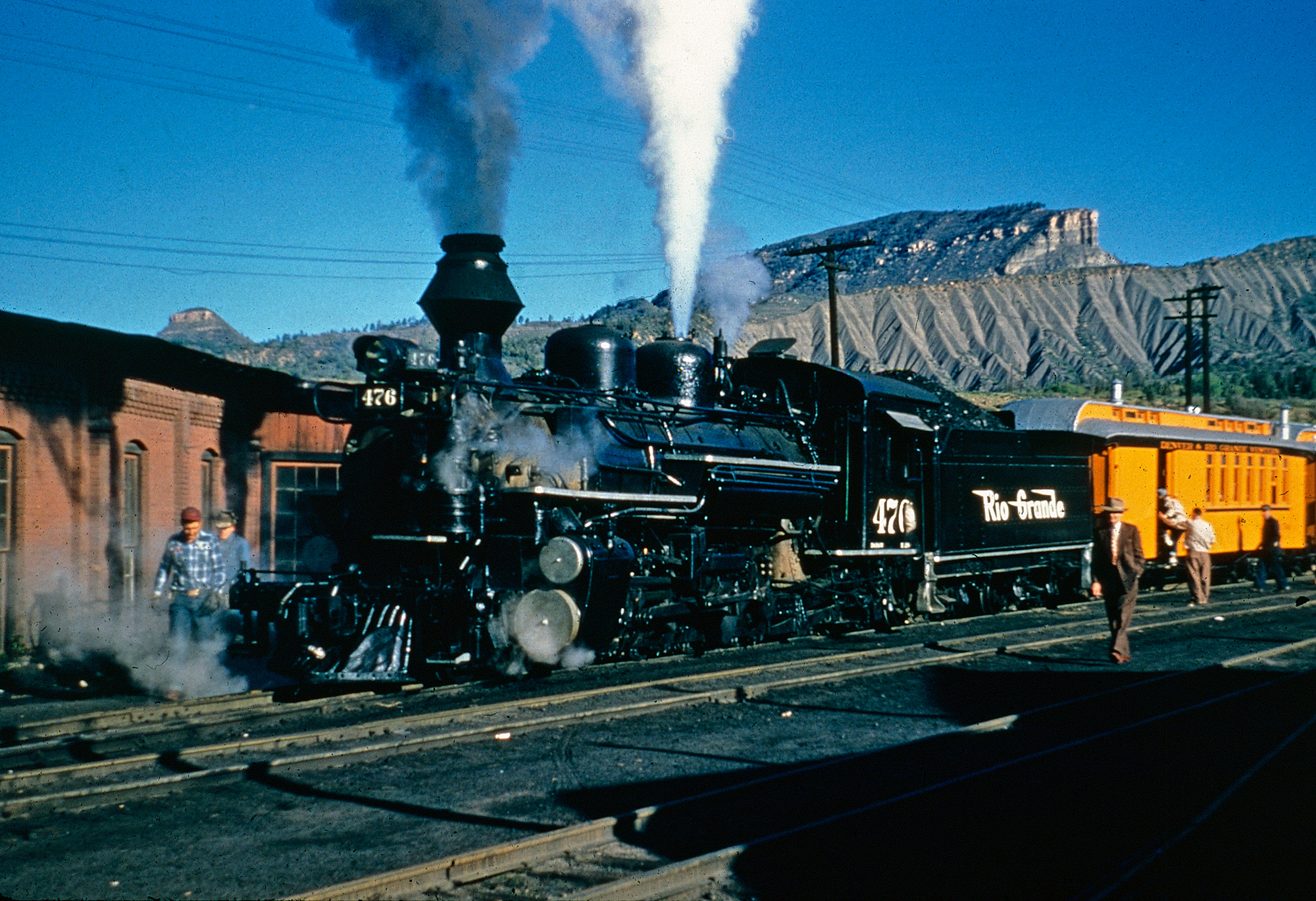California Scenic Train Rides (2025): A Complete Guide
Published: February 22, 2025
By: Adam Burns
California now offers several scenic train rides ranging from the noteworthy Napa Valley Wine Train and Fillmore & Western to the Yosemite Mountain Sugar Pine Railroad and Niles Canyon Railway. There are also numerous museums, such as the California State Railroad Museum which houses the last preserved "Cab Forward" steam locomotive
Although its first did not appear until the mid-1850's (nearly 30 years after the Granite Railway was formed on March 4, 1826), California has an illustrious history with trains. It began with the Gold Rush and grew exponentially after the Transcontinental Railroad's completion.
According to an in-depth analysis Trains Magazine published in its January, 2007 issue entitled, "Great Railroading: State-By-State," the state really was "Like Nowhere Else On Earth!" In time it was served by five major "Class I's" (Southern Pacific, Union Pacific; Atchison, Topeka & Santa Fe; Western Pacific; and Great Northern), enjoyed a healthy industrial base, contained rich agricultural lands, and eventually encompassed a network of more than 8,000 route miles.
 Southern Pacific E9A #6051 and 0-6-0 #1269 on display at the California State Railroad Museum in Sacramento, circa 1984. Mike Bledsoe photo. American-Rails.com collection.
Southern Pacific E9A #6051 and 0-6-0 #1269 on display at the California State Railroad Museum in Sacramento, circa 1984. Mike Bledsoe photo. American-Rails.com collection.California Rail History
It could be rightfully argued California single-handedly settled the West. Its lands remained in territory status for only two years (following their sale from the Mexican government as part of the 1848 Treaty of Guadalupe Hidalgo) before it achieved statehood on September 9, 1850 as the 31st state of the United States.
Nearly a decade would pass before a bordering territory would gain a similar status (Oregon, granted statehood on February 14, 1859). While the "Gold Rush" (which began after James W. Marshall found the rare metal at Sutter's Mill in Coloma on January 24, 1848) brought tens of thousands of prospectors (eventually totaling around 300,000) it was rich farmland, within the San Joaquin Valley, and seaside ports (totaling 840 miles) that transformed California into the country's most successful economy.
Its involvement with the iron horse predated the Transcontinental Railroad's completion by more than a decade. The Sacramento Valley Railroad is identified as the state's first to file articles of incorporation as a common-carrier when it was formed on August 4, 1852. (California's very first railroad put into operation was the Arcata & Mad River Railroad, established in 1854 and opened its first two miles in 1855. It was built by private interests to load lumber schooners in Humboldt Bay near Arcata.)
Four years later, on February 22, 1856, the Sacramento Valley was opened from Sacramento to Folsom (22.9 miles). In time, the SVRR would join the sprawling Southern Pacific network, a system which came to define California.
The SP'S heritage began with the Central Pacific Railroad, which completed the western leg of the Transcontinental Railroad. It was the vision of Theodore Judah who loosely formed the "Central Pacific Railroad Company of California" on November 1, 1860.
Unfortunately, Judah was later. outmaneuvered by the "Big Four" consortium of Charles Crocker, Collis P. Huntington, Mark Hopkins, and Leland Stanford. He had approached them about securing needed financing for the project but they quickly took over the endeavor after realizing its monetary potential.
They subsequently incorporated the Central Pacific Railroad of California on June 28, 1861 to "construct a railroad and telegraph line from the Pacific coast, at or near San Francisco, or the navigable waters of the Sacramento River, to the eastern boundary of California." With the passage of the Pacific Railroad Act, signed into law by President Abraham Lincoln on July 1, 1862, the CP adopted the agreement on October 7th and formally accepted it through the Department of the Interior on December 24th.
With the government's support the CP was provided land grants and federal loans for the purpose of establishing a connection with the Union Pacific (building west from Omaha, Nebraska) somewhere near the Sierra- Nevada Mountains.
The two sides, through federal remediation, eventually settled on Promontory Summit, Utah and the Transcontinental Railroad was formally completed on May 10, 1869. To learn more about this endeavor please click here. According to the book, "The Routledge Historical Atlas Of The American Railroads" by author John F. Stover, in time California was crisscrossed with ribbons of steel rail that had peaked at more than 8,300 miles by the 1920's.
The Southern Pacific was always the state's primary rail provider but several other notables would also reach its borders including the Western Pacific (its main line paralleled the SP from San Francisco/Sacramento to Salt Lake City), Santa Fe (served all of the state's major cities), Union Pacific (originally accessed only Los Angeles), and the Great Northern (completion of its "Inside Gateway" to Bieber on November 10, 1931 offered a link to the Bay Area in conjunction with the Western Pacific).
California was also home to several short lines, the world's largest interurban (Pacific Electric Railway), and several logging operations. Today, it's network totals 4,803 miles according to the Association of American Railroads.
Billy Jones Wildcat Railroad
This little operation is based in Los Gatos and provides 1/3rd-scale California scenic train rides. Its history is not that of your typical scale railroad; it all began with William "Billy" Jones, a longtime Southern Pacific.
In 1939 he located and acquired an 18-inch gauge steam locomotive designed for the Venice Miniature Railway in Venice Beach, California.
Jones then used the little steamer to establish a miniature railroad of his own to host rides for the public.
After he passed away in 1968 a local group formed a non-profit organization called the Billy Jones Wildcat Railroad, Inc. to continue operating his collection at the Oak Meadow Park and Vasona Park in Los Gatos.
It reopened in July, 1970. Today, the railroad maintains an engine house, depot, and even a water tank while offering trips over 1 mile of track.
They operate nearly year-round but have various hours depending on the seasons. The attraction has become so popular it now hosts more than 100,000 visitors annually!
Calico & Odessa Railroad
Another small railroad, this tourist attraction is based in Yermo and operates a 2-foot, 6-inch narrow gauge line through the ghost town of Calico, California (in its heyday this community produced over $20 million in silver ore from 500 local mines during a 12-year period).
The Calicao & Odessa is based from the actual Waterloo Mining Railroad, a local narrow-gauge system which hauled this silver ore from Calico to the mills of Daggett during the 1880's. (It does not, however, utilize the original right-of-way.)
California Trolley & Railroad Corporation
This museum, located in San Jose, was established in 1982 as a 501(c)(3) non-profit organization. Its primary mission aims at preserving the memory and history of rail transportation in the Santa Clara Valley.
The group has two noteworthy steam locomotives under their care, Southern Pacific 4-6-2 #2479 (Class P-10) manufactured by Baldwin in 1923 and Southern Pacific 0-6-0 #1215 (Class S-10) also built by Baldwin (1913).
They are currently working towards the complete restoration and operation of the former while the latter will remain a static display piece.
In addition, they operate a number of trolleys on a short stretch of track. Finally, their long term goals involve opening the San Jose Steam Railroad Museum which will maintain Southern Pacific's historic, six-stall Lenzen Roundhouse and turntable.
California Western Railroad, "The Skunk Train"
The famed Skunk Train, one of California's most popular scenic train rides, operates from Fort Bragg to Willits (where a connection was once made with the now-defunct Northwestern Pacific Railroad).
The heritage of this trackage, which totals 40 miles, can be traced back to the Fort Bragg Railroad that began operations in 1885 for the purpose of moving redwood logs from the rich forests of Glenblair to a mill at Fort Bragg.
After various name changes it became the California Western Railroad on December 19, 1947. Following many years moving timber products the CWR discontinued freight operations in 2001.
The carrier had operated passenger trains for many years and essentially transitioned into a tourist attraction, particularly after freight service ceased. The railroad operates both steam and diesel locomotives year-round while also hosting a number of special events.
Folsom Valley Railway/Folsom City Zoo
The Folsom Valley Railway is part of the Folsom City Zoo in Folsom, California.
The train ride has been in operation since 1970 and utilizes an authentically-scaled steam engine and cars (12-inch gauge) running on about 4/5-mile of track.
In June, 1978 the operation was taken over by Mylon Thorley from the original owners, the Sherman brothers. A little over a decade later there was another ownership change when, on January 1, 1991, Terry Gold acquired the little attraction and he remains the caretaker today.
There are currently two locomotives on the grounds; a 4-4-0 named "Cricket" (built by Erich Thompson of Berkeley Hills, California in 1950) and 4-4-2 #3001 (a project launched by Alan Shelly in 1938, it was later finished more than a decade later in 1949).
If the weather permits the railroad operates during select days of the week every month of the year.
Irvine Park Railroad
The Irvine Park Railroad is situated in Orange, California and offers scale-California train rides (1/3-scale) throughout much of the year (except major holidays, including Thanksgiving, Christmas Eve, Christmas Day, and New Year’s Day) within the Irvine Regional Park.
This recreational venue is also home to numerous other outdoor activities such as the Orange County Zoo, paddle-boat and bike rentals, pony rides, and numerous hiking trails.
The railroad began in 1996 and has transformed into one of their most popular attractions, running a sort of semi-circle loop over a portion of the property.
Also, be sure to visit the park for special events, such as their Easter Extravaganza, events for Halloween, and a special "Christmas Train!"
Finally, visit their website to learn more about hosting parties on the grounds (which includes pavilion/moon bounce rentals and even enjoy an outdoor get-together at the "Locomotive Loop").
Knott's Berry Farm
Don't let the name fool you! Scenic train rides can be found at this tourist attraction. Knott's Berry Farm provides a laundry list of family activities and is essentially a theme park. Some of these include a roller-coaster, water slides, and virtual reality game.
They even have the Mrs. Knott’s Chicken Dinner Restaurant (opened in 1934) and a hotel accommodations. Finally, one of their very popular attractions is the Calico Railroad, which operates tours around the park.
This is not a scale-train ride. The equipment is actual, full-size locomotives and cars operating on three-foot ("narrow-gauge") track.
The equipment is particularly noteworthy and historic. They include:
- Operational 2-8-0 #41 (originally built for the Rio Grande Southern in 1881 by Burnham, Parry, Williams Company [Baldwin Locomotive Works] as a Class C-19 "Consolidation" which spent many years in Colorado)
- 2-8-0 #340 under restoration (originally built for the Denver & Rio Grande in 1881 by Burnham, Parry, Williams Company [Baldwin Locomotive Works] as a Class C-19 "Consolidation")
There are also a pair of 24-inch gauge locomotives on the premises including 0-4-0T #3 (built by the Vulcan Iron Works in 1908) and 4-4-0 #83 (this locomotive is operational and was built by Crown Metal Products in 1982).
LARail.com, Inc.
One of the most luxurious of scenic train rides can be found through LA Rail, designed to whisk passengers back in time and experience what rail travel was like during the industry's "Silver Age" of streamliners.
The cars operate largely between Santa Barbara, Los Angeles and San Diego running as part of Amtrak consists. They also offer long-distance trips from time to time.
Please check their website to learn more about these adventures.
Their current fleet includes Pacific Sands (10-roomette, 6-bedroom Pullman sleeper), Silver Splendor (Vista-Dome lounge-diner), Pacific Trail (44-seat coach), Overland Trail (39-seat club/lounge), and Tioga Pass (open-observation business car).
Napa Valley Wine Train
One of the most popular scenic train rides, and well known throughout the country, is the Napa Valley Wine Train.
They offer one of the best dinner train experiences you can enjoy anywhere featuring a wide range of options (including wine, of course) aboard their train which operates through the beautiful Napa Valley region.
The train itself is operated by the Napa Valley Railroad, a reborn entity tracing back to 1864. It originally connected Calistoga and Crockett (48 miles).
The purpose of the original, just like today, was to bring tourists to Napa Valley (in this case to Calistoga, a resort city).
If you find yourself vacationing or traveling through this region's famous vineyards you may want to consider stopping for a visit to this very posh train, which spares no expense in the meal and journey!
The Napa Valley Wine Train was initially started in 1987 by local preservationists and railroad enthusiasts among stiff opposition from local communities.
After a lengthy court battle the railroad won out and was granted the right to operate the then ex-Southern Pacific trackage between Napa and St. Helena.
Niles Canyon Railway
The Niles Canyon Railway features a number of different scenic train rides on its 1 hour, 15 minute round trips, pulled by both steam and diesel locomotives.
It is one of many tourist lines in the state providing excursions on a former Southern Pacific (SP) route. This particular corridor extends a little under 10 miles with a history that can be traced back to the Civil War era.
The SP discontinued service in the mid-1980s and subsequently abandoned the line. However, thanks to the hard work of many volunteers a section was rebuilt a few years later and today provides a popular tourist attraction for thousands.
The railroad has since grown to the point it now hosts several specials throughout the year.
Pacific Southwest Railway Museum
This museum is operated by the Pacific Southwest Railway Museum Association (PSRMA) with two locations, Campo and La Mesa.
Throughout much of the year they offer excursions via a 16-mile round trip over trackage originally built by the San Diego & Arizona Railway (SD&A).
It was later sold to the Southern Pacific in 1932 whereupon the property became known as the San Diego & Arizona Eastern Railway.
There are two preserved depots maintained by the PSRMA, a former SD&A wooden structure in Campo and San Diego & Cuyamaca Railway trolley building, built in 1894, which served La Mesa.
The museum maintains a fairly sizable collection of steam and diesel locomotives along with an assortment of other equipment.
Their notable pieces include Coos Bay Lumber 2-8-2T #11 (built by Alco in 1929) that is under restoration and an eclectic collection of diesels.
Poway-Midland Railroad
Located in Poway, the Poway-Midland Railroad operates on a 0.5-mile segment of track in the city's park using a 0-4-0 steam locomotive (originally built by Baldwin Locomotive Works in April, 1907 for Cowell Cement) and a trolley car.
The arrangement carries an usual 3-foot, 6-inch narrow-gauge alignment. This little organization, owned by the city, and headed by the Poway–Midland Railroad Volunteers, Inc., has been open since 1991.
According to the railroad, its history can be traced back to a Colonel John Porter who built a small attraction on his property near Aubrey, known as the "Rattlesnake Creek Railroad."
He passed away in 1980 before the idea could be fully put into operation. However, the city subsequently purchased his railroad in 1986, which led to the volunteer group's formation and eventual operation of the property.
Some of their other better known pieces include an 1894 Los Angeles trolley car, Fairmont Speeder built in 1956, and a cable car manufactured in 1906 that originally operated in San Francisco.
Railtown 1897 State Historic Park
Railtown 1897 is located in Jamestown offering excursions pulled by steam locomotives and restored vintage railroad equipment.
They house their collection within the town's historic shops and roundhouse. Excursions are offered throughout much of the year with special events also hosted.
These trips are presented under the name of the Sierra Railway, with ties to this trackage. It dates back to 1897, originally projected to connect the California Central Valley with the Gold Country foothills.
At its largest length the railroad ran 57.43 miles from Tuolumne (serving the West Side Lumber Company's mill there) to Oakdale where interchange was established with the Southern Pacific and Santa Fe.
The name "Rail Town 1897" first appeared in 1971 when the railroad began marking excursions and slowly grew from that time forward.
In 1982 California's Department of Parks and Recreation purchased the property, renaming it as Railtown 1897 State Historic Park. Today, they offer a wide range of trips and special events throughout the year.
Redwood Valley Railway
Located inside Tilden Regional Park at Berkeley the Redwood Valley Railway offers miniature train rides on weekends year-round and weekdays during the summer.
The attraction has been around for many years; it all began in 1952 when Erich Thomsen established the Tilden South Gate & Pacific Railway, a 12-inch gauge system (later expanded to 15-inch in 1968).
Today, the railroad operates 1.25 miles of track and draws over 160,000 passengers a year.
There are five, live-steam locomotives which pull the trains:
- 0-4-0 #2 named Juniper
- 2-4-2 #4 named Laurel
- 4-4-0 #5 named Fern
- 2-6-2 #7 named Oak
- 4-6-0 #11 named Sequoia (all of these machines were manufactured locally at the organization's Redwood Valley Shops; the newest is 2-6-2 #7 built in 2006)
These miniature railroads have become increasingly popular over the years, particularly the more authentic venues with live steamers and scale-structures/equipment.
Roaring Camp Railroads
The Roaring Camp offers a number of different scenic train rides to experience. They also host special dinner trains throughout the year featuring entertainment.
What became the Roaring Camp & Big Trees Narrow Gauge Railroad was the dream of F. Norman Clark who wanted to bring back the majesty of the steam locomotive.
His idea began in the late 1950s when steam was all but gone from main line railroads. Eventually, Clark located a 2-Truck Shay in Dixiana, Virginia that had long been removed from service and rusting away.
The Shay was a classic geared steam locomotive, created by Ephraim Shay in the late 19th century and designed to pull heavy loads at slow speeds up steep, circuitous, and poor trackage.
This made it ideal for service in the timber industry while it also found use in other applications. After acquiring it in 1958 he located nearly 200 acres of ground for lease on the Big Trees Ranch in Santa Cruz County near Felton.
This area is home to a preserved virgin stand of giant redwoods, part of which now comprises the Henry Cowell Redwoods State Park.
With property acquired Clark set about constructing a 3-foot, narrow-gauge railroad that totaled just over 3 miles. Whether intended or not he was able to add to its realism by featuring very steep grades on the route, some of which topped out at over 9%!
In 1985 the Roaring Camp & Big Trees Narrow Gauge expanded its business when it launched the Santa Cruz, Big Trees & Pacific Railway.
This new system took over the former Southern Pacific's Felton Branch between Felton and Santa Cruz, a one-time narrow-gauge system.
With declining customers and washouts SP cutback the line to Rincon, which was later restored to Santa Cruz under Mr. Clark.
Fox River Train
The Fox River Train, previously known as the Sacaramento RiverTrain, is based out of West Sacramento, features upscale dinner train packages offering entertainment with your meal during the three-hour trip. They also provide special trains and events throughout the year.
The history of this line can be traced back to a noteworthy interurban, one of the longest end-to-end system of its kind, the Sacramento Northern Railway (SN).
It's so-called "Woodland Branch," originally built by the Northern Electric Railway, ran 16-miles from West Sacramento to Woodland and remains in operation today.
The SN would later join one of California's largest railroads, the Western Pacific. In 1991, WP-successor Union Pacific sold this trackage to the Yolo Shortline Railroad which went on to merge with the Sierra Railroad in 2003 and began hosting the current dinner train after that time.
San Francisco Municipal Railway
Arguably the most interesting of all scenic train rides is the San Francisco Municipal Railway. Perhaps nothing more is as quintessentially San Francisco as the city's cable cars, which have been in nearly continuous service since 1873.
The Municipal Railway keeps alive this important part of the city's history and it remains a popular tourism draw today. The system covers a nearly 50 square-mile region and hosts more than 240 million riders annually.
There are currently 82 different lines in service which are covered via bus, trolleybus, light rail, streetcar, and cable cars.
Sonoma TrainTown Railroad
This little operation, located in Sonoma and within a small theme park, offers a range of miniature train rides operating on the 15-inch scale.
The two locomotives featured include 2-6-0 #1 (built by Winton Engineering, 1960) and 4-6-4 #5212. The railroad can trace its history back to 1958, founded by Stanley L. Frank of Oakland.
As a successful businessman who held an MBA from Harvard, Frank sought to establish a 10-acre outdoor attraction which would enable the public to ride miniature trains. It began operation in 1968 and has evolved into a popular entertainment venue ever since.
While there be sure to visit their carousel and scale-roundhouse which houses the locomotives and other equipment! TrainTown is open throughout much of the year although their dates vary depending upon the seasons.
Sierra Railroad
Also operated by the same organization that owns the Skunk Train and Roaring Camp, the Sierra Railroad offers their Sierra Railroad Dinner Train, which features both dinner and entertainment.
Yosemite Mountain Sugar Pine Railroad
This narrow-gauge operation, operates 4 miles of ex-Madera Sugar Pine Lumber Company trackage near Fish Camp, California in the Sierra National Forest.
It all began in 1961 thanks to the vision of Rudy Stauffer who rebuilt part of the network (Which peaked at 140 miles running all over the mountains to reach timber reserves. Its fleet totaled seven locomotives and more than 100 log/skeleton cars.) that had closed and been removed in 1931 due to the Great Depression and loss of timber reserves.
The organization has two operating Shay geared steam locomotives, both of West Side Lumber heritage; 3-Truck #15 built by the Lima Locomotive Works in 1913 and 3-Truck #10, also manufactured by Lima in 1928.
Finally, during select times throughout the operating season the railroad operates specials known as the Moonlight Special, which feature dinner and entertainment.
Recent Articles
-
Rio Grande 2-8-2 Locomotives (K-37): Specs, Roster, Photos
Apr 15, 25 12:57 PM
Rio Grande's Class K-37 Mikes were itsdge steamers to enter service in the late 1920s. Today, all but two survive. -
Rio Grande 2-8-2 Locomotives (K-36): Specs, Roster, Photos
Apr 15, 25 11:09 AM
The Rio Grande's K-36 2-8-2s were its last new Mikados purchased for narrow-gauge use. Today, all but one survives. -
Rio Grande 2-8-2 Locomotives (Class K-28): Specs, Roster, Photos
Apr 14, 25 10:24 PM
Rio Grande's Class K-28 Mikados were its newest narrow-gauge steam locomotives since the Mudhens of the early 1900s. Today, three survive.


